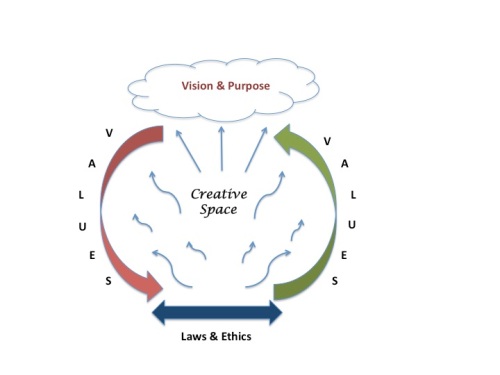 In life and work, there are many boundaries, personal ones,interpersonal ones and systemic ones. And there are also organizational boundaries. These are the ones that intrigue me most because they are the most difficult to manage and yet can be just the thing that makes growth and success possible.
In life and work, there are many boundaries, personal ones,interpersonal ones and systemic ones. And there are also organizational boundaries. These are the ones that intrigue me most because they are the most difficult to manage and yet can be just the thing that makes growth and success possible.
The trouble with organizational boundaries though, is that so often they are defined by rules and procedures that have a tendency to limit creative ability and collaborative effort. That can be very stifling for both the organization and most certainly for the people who work in it. In my mind, boundaries built on rules and procedures alone make an organization look a bit like this:
It has a rather claustrophobic feeling about it, doesn’t it? And, its walls are solid and unbending. In an atmosphere like this, I can imagine how hard it must be to engage people in creative thinking, (and doing), because really, there seems to be no way out of the ‘boundary box’. In this scenario, boundaries create a static space with little room for fresh ideas or growth.
But, let’s not get carried away. Boundaries are a necessary part of every organization. Without them, we invite chaos, distraction, and confusion with everyone running around doing their own thing and nothing meaningful being accomplished.
The thing is, boundaries don’t have to limit our ability to put our heads together and come up with ideas and activities that bring the workplace alive and produce something meaningful and fulfilling.
In fact, if expressed differently they can serve the creative process amazingly well. Here’s what it might look like:
You may notice that the Legal and Ethical boundary appears at the bottom of both images. There’s no getting away from that one. It is in no way flexible and serves as the foundation for any reputable organization’s dealings.
The vision and purpose of the organization provides the uppermost boundary. This speaks to the importance of creating, conveying and instilling a clear sense of purpose and future throughout the workforce. This is not simply about hanging framed vision statements on the wall. It is something that acts as a guide to decision makers and leaders throughout the company regardless of their position or title. It invites the question, “Does what we are about to do serve our organizational purpose and move us closer to realizing our ultimate goal?”
The boundaries on either side of the model are created by the Values the organization and its people espouse. Values express our intentional behaviour and the qualities we hold as critical to the company and what it stands for. It also invites the question, “ Does what we are planning to do honour our values? If it doesn’t, what must we do differently to ensure alignment?”
Finally, the Creative space here is not so much restricted by hard and fast rules but guided by a set of principles that makes sense to everyone. They are open to challenge. They respond to changing times and situations. And that makes the creative space alive and dynamic.
Of course, if there were a downside to this kind of boundary making, it would be the greyness of its nature. Rules are black and white, right or wrong… vision, purpose and values…not so much. These can be open to interpretation from one person to the next. As such, they require ongoing attention, management and leadership. Their messages must be constantly referenced and reinforced. And too, there must be a strong belief in the will and capability of people to see themselves in the organizational vision, working with others to fulfill its purpose and aligning themselves with the values it embraces.
For the leader, it is not easy work…not at all. To me, though, it is work worth pursuing because, done well, it increases the potential of companies to successfully build something that everyone involved can feel proud of.
That’s what I think anyway. What do you think?
Note: This post is a refreshed version of one originally published in December 2011





Thoughtful and useful. I have been working for some time on how to fit the ‘HR compliance’ and ‘contract’ work into a more creative framework and into a more useful space. This is great inspiration for how it might look.
Hi Annabel ~ one of my objectives for this blog is to offer thoughts and ideas that will be of use in the “real World”. I’m really glad this post served that purpose in some way for you. Thank you for taking the time to let me know.